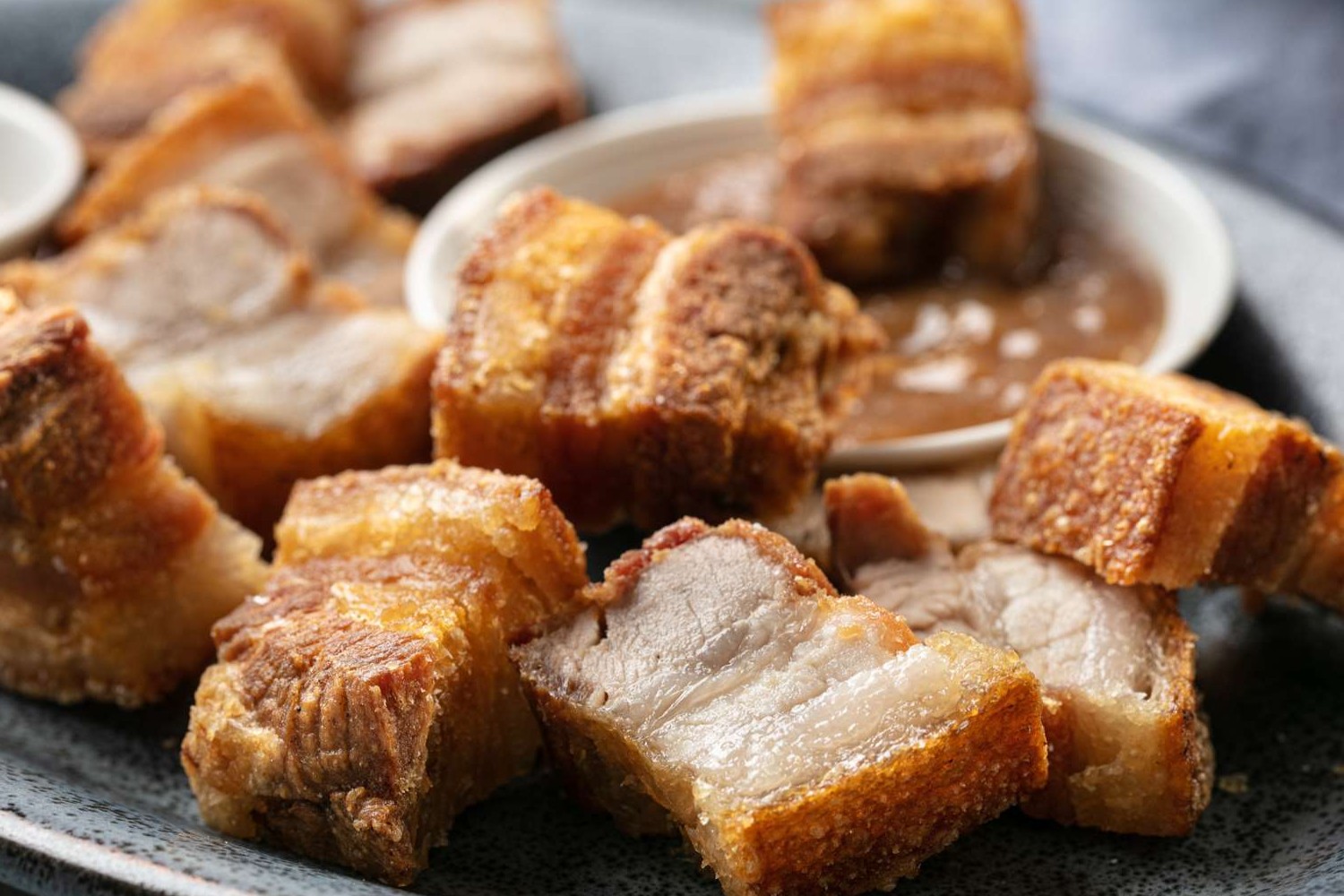Experience the rich and savory flavors of the Philippines with this delectable pork dish. The combination of tender pork belly and aromatic spices creates a comforting meal that is perfect for any occasion. Serve it hot with a side of steamed rice to fully enjoy its deliciousness.
Some ingredients in this recipe might not be commonly found in every household. Pork belly is a specific cut of meat that you may need to ask your butcher for. Additionally, bay leaves are an aromatic herb that adds depth to the dish and can usually be found in the spice aisle of your supermarket.

Ingredients For Filipino Pork Recipe
Pork belly: A fatty and flavorful cut of pork that becomes tender when cooked.
Onion: Adds sweetness and depth to the dish.
Garlic: Provides a pungent and aromatic flavor.
Soy sauce: Adds a salty and umami taste.
Vinegar: Provides acidity to balance the flavors.
Water: Helps to create the sauce and cook the pork.
Bay leaves: Adds a subtle, aromatic flavor.
Oil: Used for sautéing the garlic and onion.
Technique Tip for This Dish
To achieve a more flavorful pork belly, consider marinating it in the soy sauce and vinegar mixture for at least 30 minutes before cooking. This allows the meat to absorb the flavors more deeply, resulting in a richer taste. Additionally, when sautéing the garlic and onion, make sure they are golden brown to enhance their aromatic qualities, which will further elevate the dish.
Suggested Side Dishes
Alternative Ingredients
pork belly - Substitute with chicken thighs: Chicken thighs have a similar fat content and can provide a comparable texture and flavor.
pork belly - Substitute with beef brisket: Beef brisket is also fatty and can offer a rich, hearty flavor similar to pork belly.
onion - Substitute with shallots: Shallots have a milder taste and can provide a similar aromatic base to the dish.
onion - Substitute with leeks: Leeks offer a slightly sweeter and more delicate flavor, which can complement the dish well.
garlic - Substitute with garlic powder: Garlic powder can provide a similar flavor, though it may be less intense than fresh garlic.
garlic - Substitute with shallots: Shallots can add a mild garlic-like flavor and additional sweetness.
soy sauce - Substitute with tamari: Tamari is a gluten-free alternative that offers a similar umami flavor.
soy sauce - Substitute with coconut aminos: Coconut aminos are a soy-free option that provides a slightly sweeter, yet similar, flavor profile.
vinegar - Substitute with lemon juice: Lemon juice can provide the necessary acidity and a fresh, tangy flavor.
vinegar - Substitute with apple cider vinegar: Apple cider vinegar offers a similar acidity with a slightly fruity undertone.
water - Substitute with chicken broth: Chicken broth can add more depth and flavor to the dish.
water - Substitute with vegetable broth: Vegetable broth can provide additional flavor while keeping the dish lighter.
bay leaves - Substitute with thyme: Thyme can offer a similar earthy and aromatic quality to the dish.
bay leaves - Substitute with oregano: Oregano can provide a robust and slightly bitter flavor that complements the dish well.
oil - Substitute with butter: Butter can add a rich, creamy texture and flavor to the dish.
oil - Substitute with ghee: Ghee offers a nutty flavor and high smoke point, making it a good alternative for cooking.
Other Alternative Recipes Similar to This Dish
How to Store / Freeze This Dish
Allow the pork belly to cool completely before storing. This prevents condensation, which can lead to soggy textures and spoilage.
Transfer the cooled pork belly into an airtight container. This helps maintain its flavor and prevents it from absorbing other odors in the fridge.
Store the container in the refrigerator if you plan to consume the dish within 3-4 days. This ensures the pork belly remains fresh and safe to eat.
For longer storage, place the pork belly in a freezer-safe container or heavy-duty freezer bags. Squeeze out as much air as possible to prevent freezer burn.
Label the container or bag with the date of storage. This helps you keep track of how long the pork belly has been stored and ensures you use it within a safe timeframe.
When ready to reheat, thaw the pork belly in the refrigerator overnight. This gradual thawing process helps maintain the texture and flavor of the dish.
Reheat the pork belly in a pot over medium heat until it reaches an internal temperature of 165°F (74°C). This ensures the dish is heated through and safe to eat.
Alternatively, you can reheat the pork belly in the microwave. Place it in a microwave-safe dish, cover it with a microwave-safe lid or wrap, and heat on medium power in 1-minute intervals, stirring occasionally, until thoroughly heated.
If you notice any off smells, discoloration, or changes in texture, discard the pork belly. These are signs that the dish may have spoiled and is no longer safe to eat.
How to Reheat Leftovers
Stovetop Method: Place the leftover pork belly in a skillet or saucepan. Add a splash of water or broth to prevent it from drying out. Cover and heat over medium-low heat, stirring occasionally, until warmed through.
Microwave Method: Transfer the pork belly to a microwave-safe dish. Cover with a microwave-safe lid or plastic wrap, leaving a small vent. Heat on medium power in 1-minute intervals, stirring in between, until evenly heated.
Oven Method: Preheat your oven to 350°F (175°C). Place the pork belly in an oven-safe dish and cover with foil. Bake for about 15-20 minutes, or until heated through. For a crispy finish, remove the foil during the last 5 minutes of reheating.
Steaming Method: Place the pork belly in a heatproof dish that fits into your steamer. Steam over boiling water for about 10-15 minutes, or until thoroughly heated. This method helps retain moisture and tenderness.
Air Fryer Method: Preheat your air fryer to 350°F (175°C). Place the pork belly in the air fryer basket in a single layer. Heat for about 5-7 minutes, shaking the basket halfway through, until the pork is hot and slightly crispy.
Best Tools for Cooking This Dish
Pot: A large cooking vessel used to heat the oil and cook the pork belly.
Stove: The heat source for cooking the ingredients.
Knife: Used to chop the onion and mince the garlic.
Cutting board: A surface for safely chopping the onion and mincing the garlic.
Wooden spoon: Used to sauté the garlic and onion, and stir the pork belly.
Measuring spoons: Used to measure the soy sauce, vinegar, and oil accurately.
Measuring cup: Used to measure the water.
Serving spoon: Used to serve the cooked dish.
Rice cooker: An optional tool for cooking rice to serve with the dish.
How to Save Time on This Recipe
Prep ingredients in advance: Chop the onion and mince the garlic ahead of time to streamline the cooking process.
Use a pressure cooker: Cut down the simmering time by using a pressure cooker to tenderize the pork belly faster.
Marinate overnight: Let the pork belly soak in soy sauce and vinegar overnight to enhance flavor and reduce cooking time.
Batch cooking: Double the recipe and freeze half for a quick meal later.
Pre-measure liquids: Measure out the soy sauce, vinegar, and water before you start cooking.

Filipino Pork Recipe
Ingredients
Main Ingredients
- 1 kg pork belly cut into cubes
- 1 onion chopped
- 4 cloves garlic minced
- 2 tablespoon soy sauce
- 2 tablespoon vinegar
- 1 cup water
- 2 bay leaves
- Salt and pepper to taste
- 1 tablespoon oil
Instructions
- Heat oil in a pot over medium heat.
- Add garlic and onion, sauté until fragrant.
- Add pork belly, cook until browned.
- Pour in soy sauce, vinegar, and water.
- Add bay leaves, salt, and pepper.
- Bring to a boil, then simmer for 45 minutes.
- Serve hot with rice.
Nutritional Value
Keywords
Suggested Appetizers and Desserts
More Amazing Recipes to Try 🙂
- Thai Coconut Fish Curry Recipe35 Minutes
- Thai Pork Tenderloin Recipe40 Minutes
- Vegan Thai Curry Recipe45 Minutes
- Thai Tom Yum Soup Recipe35 Minutes
- Thai Rice Balls Recipe30 Minutes
- Thai Pandan Recipe45 Minutes
- Kabocha Stir Fry Recipe35 Minutes
- Thai Chicken Skewers Name Recipe35 Minutes

Leave a Reply